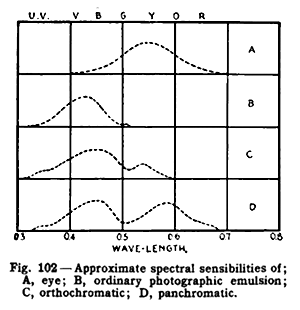|
OPN1MW2
OPN1MW2 is a duplication of the OPN1MW gene, which encodes the medium wavelength sensitive (MWS) photopsin. The gene duplication is present in about 50% of X-chromosomes, so is present in 50% of males and at least once 75% of females. It caused by the same mechanism that causes congenital red-green color blindness, the most common form of color blindness. Gene Duplication OPN1MW2 is a duplication of the OPN1MW gene arising from unequal homologous recombination. During this process, one of the X-chromosomes "donates" its OPN1MW gene to the other chromosome, resulting in: * One chromosome without a OPN1MW gene, which carries congenital red-green color blindness, protanopia * One chromosome with two OPN1MW genes, although only the first gene in the chain (OPN1MW1) will generally be gene expression, expressed and the second gene OPN1MW2 will remain unexpressed. The only difference between the two genes is their position in the gene cluster. They are equal in that they have the same ... [...More Info...] [...Related Items...] OR: [Wikipedia] [Google] [Baidu] |
Tetrachromacy
Tetrachromacy (from Ancient Greek ''tetra'', meaning "four" and ''chroma'', meaning "color") is the condition of possessing four independent channels for conveying color information, or possessing four types of cone cell in the eye. Organisms with tetrachromacy are called tetrachromats. In tetrachromatic organisms, the sensory color space is four-dimensional, meaning that matching the sensory effect of arbitrarily chosen spectra of light within their visible spectrum requires mixtures of at least four primary colors. Tetrachromacy is demonstrated among several species of birds, fishes, and reptiles. The common ancestor of all vertebrates was a tetrachromat, but a common ancestor of mammals lost two of its four kinds of cone cell, evolving dichromacy, a loss ascribed to the conjectured nocturnal bottleneck. Some primates then later evolved a third cone. Physiology The normal explanation of tetrachromacy is that the organism's retina contains four types of higher-intensity lig ... [...More Info...] [...Related Items...] OR: [Wikipedia] [Google] [Baidu] |
OPN1MW
Green-sensitive opsin is a protein that in humans is encoded by the ''OPN1MW'' gene. OPN1MW2 is a similar opsin. The OPN1MW gene provides instructions for making an opsin pigment that is more sensitive to light in the middle of the visible spectrum (yellow/green light). See also * Opsin * OPN1LW OPN1LW is a gene on the X chromosome that encodes for long wave sensitive (LWS) opsin, or red cone photopigment. The OPN1LW gene provides instructions for making an opsin pigment that is more sensitive to light in the yellow/orange part of the vis ... References Further reading * * * * * * * * * * * * * External links GeneReviews/NIH/NCBI/UW entry on Red-Green Color Vision Defects G protein-coupled receptors Color vision {{transmembranereceptor-stub ... [...More Info...] [...Related Items...] OR: [Wikipedia] [Google] [Baidu] |
Photopsin
Vertebrate visual opsins are a subclass of ciliary opsins and mediate vision in vertebrates. They include the opsins in human rod and cone cells. They are often abbreviated to ''opsin'', as they were the first opsins discovered and are still the most widely studied opsins. Opsins Opsin refers strictly to the apoprotein (without bound retinal). When an opsin binds retinal to form a holoprotein, it is referred to as Retinylidene protein. However, the distinction is often ignored, and opsin may refer loosely to both (regardless of whether retinal is bound). Opsins are G-protein-coupled receptors (GPCRs) and must bind retinal — typically 11-''cis''-retinal — in order to be photosensitive, since the retinal acts as the chromophore. When the Retinylidene protein absorbs a photon, the retinal isomerizes and is released by the opsin. The process that follows the isomerization and renewal of retinal is known as the visual cycle. Free 11-''cis''-retinal is photosensitiv ... [...More Info...] [...Related Items...] OR: [Wikipedia] [Google] [Baidu] |
Congenital Red-green Color Blindness
A birth defect is an abnormal condition that is present at birth, regardless of its cause. Birth defects may result in disabilities that may be physical, intellectual, or developmental. The disabilities can range from mild to severe. Birth defects are divided into two main types: structural disorders in which problems are seen with the shape of a body part and functional disorders in which problems exist with how a body part works. Functional disorders include metabolic and degenerative disorders. Some birth defects include both structural and functional disorders. Birth defects may result from genetic or chromosomal disorders, exposure to certain medications or chemicals, or certain infections during pregnancy. Risk factors include folate deficiency, drinking alcohol or smoking during pregnancy, poorly controlled diabetes, and a mother over the age of 35 years old. Many birth defects are believed to involve multiple factors. Birth defects may be visible at birth or diagno ... [...More Info...] [...Related Items...] OR: [Wikipedia] [Google] [Baidu] |
Color Blindness
Color blindness, color vision deficiency (CVD) or color deficiency is the decreased ability to color vision, see color or differences in color. The severity of color blindness ranges from mostly unnoticeable to full absence of color perception. Color blindness is usually a Sex linkage, sex-linked Heredity, inherited problem or variation in the functionality of one or more of the three classes of cone cells in the retina, which mediate color vision. The most common form is caused by a genetic condition called congenital red–green color blindness (including protan and deutan types), which affects ''up to'' 1 in 12 males (8%) and 1 in 200 females (0.5%). The condition is more prevalent in males, because the opsin genes responsible are located on the X chromosome. Rarer genetic conditions causing color blindness include congenital blue–yellow color blindness (tritan type), blue cone monochromacy, and achromatopsia. Color blindness can also result from physical or chemical dam ... [...More Info...] [...Related Items...] OR: [Wikipedia] [Google] [Baidu] |
Homologous Recombination
Homologous recombination is a type of genetic recombination in which genetic information is exchanged between two similar or identical molecules of double-stranded or single-stranded nucleic acids (usually DNA as in Cell (biology), cellular organisms but may be also RNA in viruses). Homologous recombination is widely used by cells to accurately DNA repair, repair harmful DNA breaks that occur on both strands of DNA, known as double-strand breaks (DSB), in a process called homologous recombinational repair (HRR). Homologous recombination also produces new combinations of DNA sequences during meiosis, the process by which eukaryotes make gamete cells, like sperm and ovum, egg cells in animals. These new combinations of DNA represent genetic variation in offspring, which in turn enables populations to Adaptation, adapt during the course of evolution. Homologous recombination is also used in horizontal gene transfer to exchange genetic material between different strains and species ... [...More Info...] [...Related Items...] OR: [Wikipedia] [Google] [Baidu] |
Gene Expression
Gene expression is the process (including its Regulation of gene expression, regulation) by which information from a gene is used in the synthesis of a functional gene product that enables it to produce end products, proteins or non-coding RNA, and ultimately affect a phenotype. These products are often proteins, but in non-protein-coding genes such as Transfer RNA, transfer RNA (tRNA) and Small nuclear RNA, small nuclear RNA (snRNA), the product is a functional List of RNAs, non-coding RNA. The process of gene expression is used by all known life—eukaryotes (including multicellular organisms), prokaryotes (bacteria and archaea), and viruses—to generate the macromolecule, macromolecular machinery for life. In genetics, gene expression is the most fundamental level at which the genotype gives rise to the phenotype, ''i.e.'' observable trait. The genetic information stored in DNA represents the genotype, whereas the phenotype results from the "interpretation" of that informati ... [...More Info...] [...Related Items...] OR: [Wikipedia] [Google] [Baidu] |
Gene Cluster
A gene cluster is a group of two or more genes found within an organism's DNA that encode similar peptide, polypeptides or proteins which collectively share a generalized function and are often located within a few thousand base pairs of each other. The size of gene clusters can vary significantly, from a few genes to several hundred genes. Portions of the DNA sequence of each gene within a gene cluster are found to be identical; however, the protein encoded by each gene is distinct from the proteins encoded by the other genes within the cluster. Gene clusters often result from expansions of a single gene caused by repeated duplication events, and may be observed near one another on the same chromosome or on different, but homologous chromosomes. An example of a gene cluster is the Hox gene, which is made up of eight genes and is part of the Homeobox gene family. Formation Historically, four models have been proposed for the formation and persistence of gene clusters. Gene dupli ... [...More Info...] [...Related Items...] OR: [Wikipedia] [Google] [Baidu] |
Hereditary Carrier
A hereditary carrier (genetic carrier or just carrier), is a person or other organism that has Genetics, inherited a recessive allele for a genetic trait or mutation but usually does not display that genetic trait, trait or show symptoms of the Genetic disease, disease. Carriers are, however, able to Heredity, pass the allele onto their offspring, who may then express the genetic trait. Carriers in autosomal inheritances Autosomal dominant-recessive inheritance (biology)#obligatory data, inheritance is made possible by the fact that the individuals of most species (including all higher animals and plants) have two alleles of most hereditary predispositions because the chromosomes in the cell nucleus are usually present in pairs (diploid). Carriers can be female or male as the autosomes are homologous independently from the sex. In carriers the expression of a certain characteristic is recessive. The individual has both a genetic predisposition for the dominance (genetics), domi ... [...More Info...] [...Related Items...] OR: [Wikipedia] [Google] [Baidu] |
OPN1LW
OPN1LW is a gene on the X chromosome that encodes for long wave sensitive (LWS) opsin, or red cone photopigment. The OPN1LW gene provides instructions for making an opsin pigment that is more sensitive to light in the yellow/orange part of the visible spectrum (long-wavelength light). The gene contains 6 exons with variability that induces shifts in the spectral range. OPN1LW is subject to homologous recombination with OPN1MW, as the two have very similar sequences. These recombinations can lead to various vision problems, such as red-green colourblindness and blue monochromacy. The protein encoded is a G-protein coupled receptor with embedded 11-''cis''-retinal, whose light excitation causes a cis-trans conformational change that begins the process of chemical signalling to the brain. It is responsible for perception of visible light in the yellow-green range on the visible spectrum (around 500-570nm). Gene OPN1LW produces red-sensitive opsin, while its counterparts, OPN1MW ... [...More Info...] [...Related Items...] OR: [Wikipedia] [Google] [Baidu] |
Spectral Sensitivity
Spectral sensitivity is the relative efficiency of detection, of light or other signal, as a function of the frequency or wavelength of the signal. In visual neuroscience, spectral sensitivity is used to describe the different characteristics of the photopigments in the rod cells and cone cells in the retina of the eye. It is known that the rod cells are more suited to scotopic vision and cone cells to photopic vision, and that they differ in their sensitivity to different wavelengths of light. It has been established that the maximum spectral sensitivity of the human eye under daylight conditions is at a wavelength of 555 nm, while at night the peak shifts to 507 nm. In photography, film and sensors are often described in terms of their spectral sensitivity, to supplement their characteristic curves that describe their responsivity. A database of camera spectral sensitivity is created and its space analyzed. For X-ray films, the spectral sensitivity is chosen t ... [...More Info...] [...Related Items...] OR: [Wikipedia] [Google] [Baidu] |





